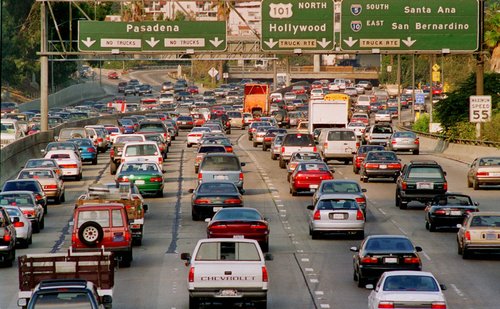Transportation equity issues take a much different form in much of Latin American than it does in the United States. Mexico City is a strong example of this. Unlike U.S. cities that have experienced significant decline in their centers while the suburbs have flourished, Mexico City’s periphery is a region of impoverished and underserved populations. This periphery has been growing much faster than the rest of the city as people from the city and the countryside drawn to Mexico City for its inherent economic opportunities, but cannot afford to live in the city itself.
Source: Adrián G. Aguilar, Peter Ward, and C. B. Smith, Sr., “Globalization, Regional Development, and Meta-city Expansion in Latin America: Analyzing Mexico City’s Peri-
Urban Hinterland,” Cities 20 no. 1 (February 2003): 10.
This pattern reinforces the cycle of income inequality as households on the urban fringe must spend on average 25% of their income on the commute into and out of the city. Much of this is due to the lack of public transportation options available in the area. The two main options are the colectivos--privately owned microbuses that run unregulated routes with frequent stops--and automobiles. Both of these modes are expensive, time-consuming and intensive contributors to both the congestion and negative environmental impacts of Mexico City.
There is a strong public transportation system that has been very successful in Mexico City, but the bus, BRT and rail lines stop at the edge of the Distrito Federal (DF) and do not serve the entire metro area with a single exception. This exception is a rail line serving a wealthy suburb of the city that has reduced commute times from 2.5 hours to 25 minutes. While there is ample potential ridership and support for BRT and rail in the peri-urban areas, they lack political voice and are consistently marginalized in the transportation network.
Mexico City finds itself at a crucial point in its transportation network. It needs to capitalize on the current political rhetoric on climate change and the recent success of the BRT system to extend Metrobus to the peri-urban areas. The suburban rail line has shown the tremendous impact public transit can have on the periphery with drastically reduced commute times while improving air quality, congestion and affordability by switching from automobiles and colectivos to train. By extending the BRT system coupled with low level government subsidies creating a fare subsidy for these regions, Mexico City can make significant strides towards reducing income inequality, providing more environmentally friendly transportation options to underserved populations and reducing congestion in the central city.
If you have an interest in peri-urban areas or transportation equity in Mexico City I strongly recommend reading the article Bringing in the Peri-Urban Poor: Expanding Mexico City’s Transportation Network by Sophia Cristina Peters.


Interesting post, Mike. With the success of all the recent transportation projects within the city, I'm surprised there are so few options for residents outside the city limits. The metropolitan area has an additional six cities with a population over half a million people (and two over a million), so these issues clearly need to be addressed. As you mention, it certainly seems like the ideal time for the region to build on Mexico City's BRT and rail lines and expand them throughout the region.
ReplyDeleteCould Mexico City afford such an expansion? I do not know how they fund their transit. Would providing such service to a largely impoverished community be over-taxing their system? I guess I'm thinking that that community's taxes or land values or however the city receives money for the system, would not be proportional to the amount (length of track, number of lines) of transit that would be required to adequately serve them.
ReplyDeleteThere is also the double-edged sword that building out to suburbs only encourages further development, but, as you said, Mexico City is not like those in the U.S. Any thoughts on these questions?